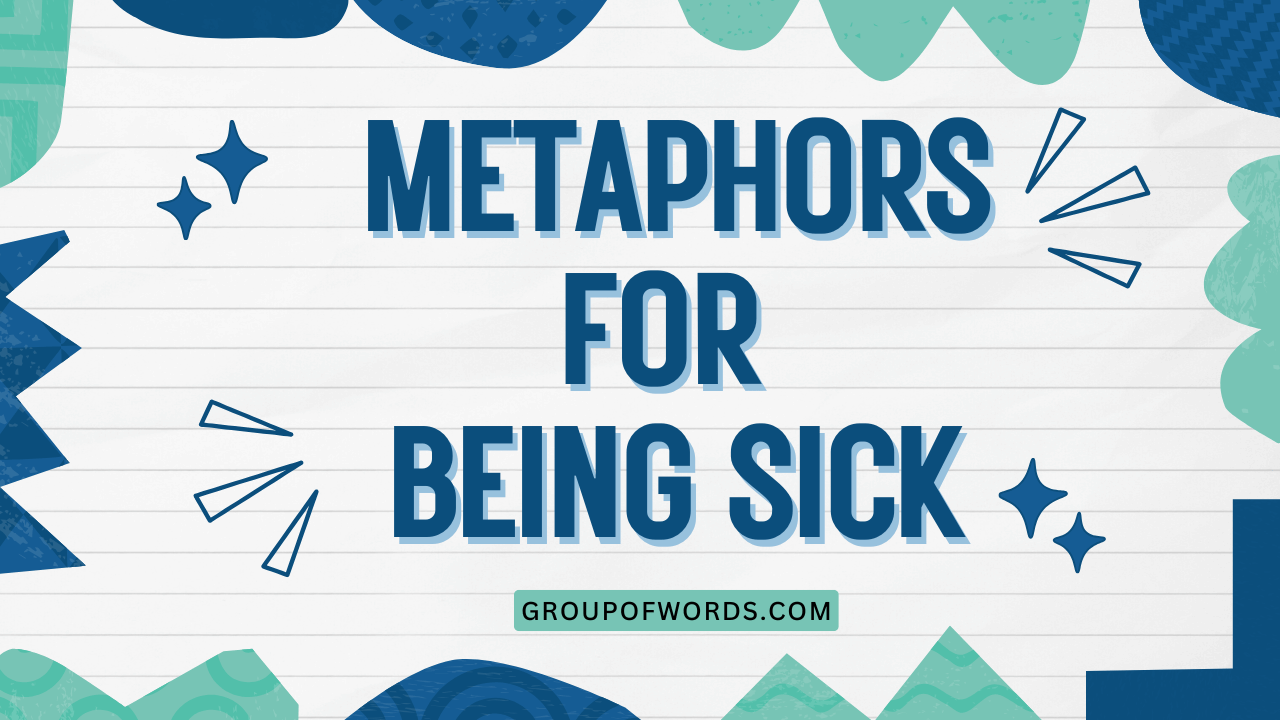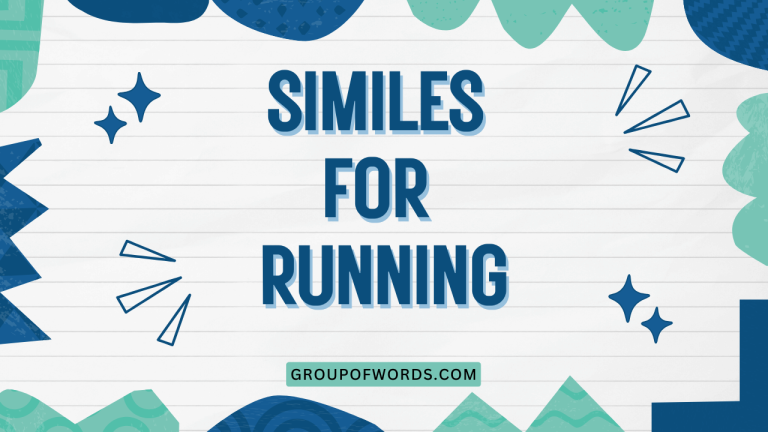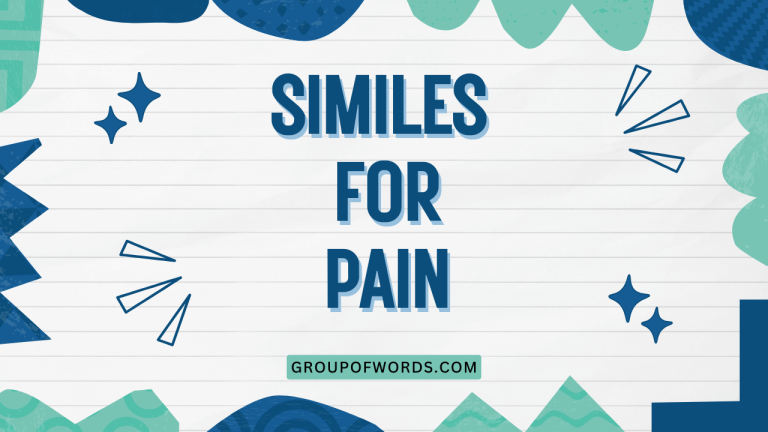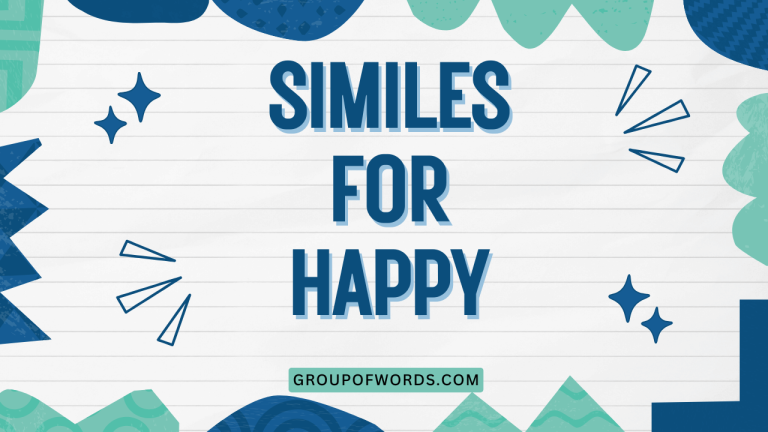Metaphors for Being Sick: A Comprehensive Guide
Understanding how we use metaphors to describe illness is crucial for mastering English. Metaphors allow us to express complex and often uncomfortable feelings associated with sickness in relatable terms.
This article explores various metaphors for being sick, their structural nuances, and how to use them effectively. Whether you’re an ESL learner, a student of linguistics, or simply interested in the nuances of English, this guide will provide a comprehensive overview of this fascinating aspect of language.
Table of Contents
- Introduction
- Definition of Metaphors for Being Sick
- Structural Breakdown
- Types and Categories of Sickness Metaphors
- Examples of Sickness Metaphors
- Usage Rules for Sickness Metaphors
- Common Mistakes with Sickness Metaphors
- Practice Exercises
- Advanced Topics
- Frequently Asked Questions
- Conclusion
Definition of Metaphors for Being Sick
A metaphor for being sick is a figure of speech that describes illness or a state of unwellness by comparing it to something else, without using “like” or “as.” These metaphors help us understand and communicate the subjective experience of illness in more concrete and relatable terms. They function by transferring qualities or characteristics from one domain (e.g., war, weather) to the domain of illness.
Metaphors are not literal; instead, they offer an imaginative comparison that resonates with the listener or reader. They can be incredibly powerful in conveying the severity, impact, or emotional toll of an illness.
The context in which a metaphor is used significantly influences its interpretation. For example, saying someone is “battling cancer” evokes a sense of struggle and resilience, while saying they are “drowning in fatigue” emphasizes overwhelming exhaustion.
Structural Breakdown
The structure of a sickness metaphor typically involves two key components: the tenor and the vehicle. The tenor is the subject being described (in this case, the illness or the feeling of being sick), and the vehicle is the object or concept to which the tenor is being compared.
For instance, in the metaphor “He’s fighting a fever,” the tenor is “fever,” and the vehicle is “fighting.” The vehicle lends its qualities (struggle, opposition, effort) to the tenor, helping us understand the experience of having a fever as a battle against an opposing force.
The effectiveness of a metaphor depends on the shared understanding and cultural context between the speaker and the listener. A metaphor that resonates with one person might not resonate with another if their experiences or cultural backgrounds differ.
The underlying meaning is implicit and requires interpretation.
Types and Categories of Sickness Metaphors
Metaphors for being sick can be categorized based on the types of comparisons they make. Here are some common categories:
War and Battle Metaphors
These metaphors portray illness as a conflict, often emphasizing struggle, resistance, and the need for strength. They are commonly used to describe serious or chronic illnesses.
Weight and Burden Metaphors
These metaphors describe illness in terms of heaviness, pressure, or a load that someone is carrying. They often highlight the emotional and physical toll of being sick.
Weather and Storm Metaphors
These metaphors compare illness to natural phenomena like storms, floods, or extreme weather conditions. They often convey the unpredictable and overwhelming nature of sickness.
Mechanical Breakdown Metaphors
These metaphors liken the body to a machine that has malfunctioned or broken down. They focus on the physical aspects of illness and the loss of normal function.
Animal-like Metaphors
These metaphors compare the experience of being sick to certain behaviors or conditions associated with animals. They can be used to describe feelings of weakness, vulnerability, or discomfort.
Examples of Sickness Metaphors
Below are several tables presenting examples of sickness metaphors, categorized by type. Each table includes numerous examples to illustrate the variety and richness of this linguistic phenomenon.
Table 1: War and Battle Metaphors
This table showcases examples of how illness is metaphorically described as a war or battle. These metaphors often highlight the struggle and effort involved in overcoming the illness.
| Metaphor | Explanation |
|---|---|
| He’s battling cancer. | Implies a fight against a serious illness. |
| She’s fighting off a cold. | Suggests actively resisting the onset of a cold. |
| The virus is attacking her immune system. | Presents the virus as an aggressive enemy. |
| He lost his battle with the disease. | Indicates the illness was ultimately fatal. |
| She is waging war on her allergies. | Suggests a constant and ongoing struggle. |
| The doctors are on the front lines fighting the epidemic. | Depicts medical professionals as soldiers in a war. |
| He is armed with antibiotics to combat the infection. | Presents antibiotics as weapons. |
| The body’s defenses are weakened. | Refers to the immune system as a military defense. |
| She surrendered to the flu. | Indicates a complete loss of energy and the inability to fight back. |
| The medication is her secret weapon against the pain. | Presents medication as a strategic tool in the fight against pain. |
| He’s in a constant skirmish with his chronic illness. | Suggests frequent, minor battles against the illness. |
| The virus launched an offensive. | Depicts the virus as actively and aggressively spreading. |
| She is building up her defenses against the seasonal allergies. | Implies strengthening the immune system to resist allergies. |
| He retreated from the world while he recovered. | Suggests withdrawing from normal activities to heal. |
| The disease is relentless in its assault. | Highlights the persistent and aggressive nature of the illness. |
| She’s holding her ground against the nausea. | Implies resisting the feeling of nausea. |
| The therapy is helping him regain lost ground. | Suggests making progress in recovery. |
| He’s a warrior in his fight against Parkinson’s. | Elevates the person to a heroic status in their struggle. |
| The pain was a constant barrage. | Depicts the pain as relentless and overwhelming. |
| She’s strategizing her recovery. | Implies careful planning and tactics in the recovery process. |
| He’s a casualty of the flu season. | Presents the person as a victim of the flu. |
| The illness is laying siege to his body. | Depicts the illness as surrounding and attacking the body. |
| She’s fortifying her body with vitamins. | Implies strengthening the body’s defenses with vitamins. |
| He refuses to yield to the illness. | Suggests a strong determination to overcome the sickness. |
| The disease is his nemesis. | Presents the disease as a formidable and persistent enemy. |
Table 2: Weight and Burden Metaphors
This table illustrates metaphors that describe illness as a weight or burden. These metaphors often convey the emotional and physical strain associated with being sick.
| Metaphor | Explanation |
|---|---|
| She’s weighed down by fatigue. | Implies that fatigue is a heavy burden. |
| The illness is a heavy load to bear. | Suggests that the illness is a significant burden. |
| He feels crushed by the symptoms. | Conveys the overwhelming nature of the symptoms. |
| The sickness is a burden on her family. | Highlights the impact of the illness on loved ones. |
| The diagnosis hit him like a ton of bricks. | Indicates the shock and impact of receiving bad news. |
| She’s carrying the weight of the world on her shoulders with this illness. | Suggests an immense burden of responsibility and worry. |
| He’s drowning in medical bills. | Conveys the overwhelming financial burden of healthcare. |
| The pain is a constant drag on her energy. | Implies that the pain is continuously draining her vitality. |
| She’s feeling the immense pressure of recovery. | Highlights the stress and demands of the healing process. |
| The sickness is a heavy cross to bear. | Suggests enduring suffering with resilience and fortitude. |
| He’s burdened by the side effects of the medication. | Implies that the side effects are a troublesome load. |
| She feels like she’s sinking under the weight of her illness. | Conveys a feeling of being overwhelmed and defeated. |
| The illness has cast a shadow over her life. | Suggests that the illness has darkened her outlook and experiences. |
| He’s carrying the stigma of the disease. | Implies that the social judgment associated with the illness is a burden. |
| She feels the oppressive weight of the diagnosis. | Highlights the emotional heaviness of receiving the diagnosis. |
| The fatigue is like an anchor, holding her back. | Suggests that fatigue is preventing her from moving forward. |
| He’s shouldering the responsibility of managing his condition. | Implies that he is taking on the burden of managing his health. |
| She’s weighed down by the fear of relapse. | Conveys the anxiety and worry associated with the possibility of the illness returning. |
| The pain is a millstone around his neck. | Suggests that the pain is a constant and inescapable burden. |
| He’s crumbling under the strain of the illness. | Implies that the illness is causing him to weaken and deteriorate. |
| She’s staggering under the weight of her symptoms. | Conveys the difficulty of coping with the symptoms. |
| The illness is a lead weight in her heart. | Suggests that the illness is causing emotional heaviness and sadness. |
| He feels buried under the demands of treatment. | Implies that the treatment requirements are overwhelming. |
| She’s weighed down by the expectations of others. | Conveys the pressure to recover and return to normal life. |
| The illness has put a damper on her spirits. | Suggests that the illness has diminished her enthusiasm and joy. |
Table 3: Weather and Storm Metaphors
This table provides examples of metaphors that compare illness to weather phenomena. These metaphors often convey the unpredictable and overwhelming nature of sickness.
| Metaphor | Explanation |
|---|---|
| She’s weathering the storm of her illness. | Implies enduring a difficult period of sickness. |
| The fever came in waves. | Suggests that the fever intensity fluctuated. |
| He’s under the weather. | A common expression for feeling unwell. |
| The pain is like a thunderclap. | Conveys a sudden and intense sensation of pain. |
| She feels washed out from the sickness. | Suggests feeling drained and exhausted. |
| He’s going through a rough patch with his health. | Implies a difficult period of illness or recovery. |
| The symptoms are raging like a hurricane. | Conveys the intense and destructive nature of the symptoms. |
| She’s in the eye of the storm with her treatment. | Suggests a brief period of calm amidst a turbulent process. |
| He’s clouded by confusion due to the medication. | Implies that the medication is causing mental fogginess. |
| The illness is a dark cloud hanging over her. | Suggests that the illness is casting a shadow of sadness and worry. |
| She’s thawing out after a long period of illness. | Implies a gradual recovery and return to vitality. |
| He’s caught in a whirlwind of medical appointments. | Conveys the hectic and overwhelming nature of treatment schedules. |
| The nausea is like a brewing storm. | Suggests that the nausea is building up and about to intensify. |
| She’s feeling the aftershocks of the illness. | Implies lingering effects and residual symptoms. |
| He’s navigating the turbulent waters of recovery. | Conveys the challenges and uncertainties of the healing process. |
| She’s in a drought of energy. | Suggests a severe lack of vitality and stamina. |
| He’s feeling the chill of the illness. | Implies a sense of discomfort and unease. |
| She’s been hit by a wave of fatigue. | Conveys a sudden and overwhelming feeling of exhaustion. |
| He’s trying to stay afloat amidst the symptoms. | Suggests struggling to cope with the challenges of the illness. |
| She’s feeling the heat of the fever. | Implies a strong and intense sensation of fever. |
| He’s waiting for the storm to pass. | Suggests patiently enduring the difficult period of illness. |
| She’s feeling the drizzle of a lingering cough. | Implies a persistent but mild cough. |
| He’s caught in a fog of medication side effects. | Conveys a sense of mental confusion and disorientation. |
| She’s seeing light at the end of the tunnel with her recovery. | Suggests hope and progress in the healing process. |
| He’s feeling the gentle breeze of improved health. | Implies a gradual and subtle improvement in well-being. |
Table 4: Mechanical Breakdown Metaphors
This table presents metaphors that describe illness as a mechanical breakdown. These metaphors often focus on the physical aspects of illness and the loss of normal function.
| Metaphor | Explanation |
|---|---|
| His body is running on fumes. | Implies that he has very little energy left. |
| She feels like her engine is sputtering. | Suggests that her body is functioning erratically. |
| He’s a bit rusty after being sick. | Conveys a feeling of being stiff and out of practice. |
| Her system is overloaded. | Suggests that her body is unable to cope with the demands placed on it. |
| He’s running out of steam. | Implies that he is losing energy and motivation. |
| Her batteries are completely drained. | Suggests that she is extremely tired and exhausted. |
| He feels like his wires are crossed. | Conveys a sense of mental confusion and disorganization. |
| Her body is malfunctioning. | Implies that her body is not functioning properly. |
| He’s feeling the wear and tear of the illness. | Suggests that the illness has taken a toll on his body. |
| Her immune system is on the fritz. | Implies that her immune system is not working correctly. |
| He feels like his hard drive has crashed. | Conveys a sense of mental shutdown and inability to think clearly. |
| Her body is in need of a tune-up. | Suggests that her body needs some care and attention to function properly. |
| He’s running at half speed. | Implies that he is functioning at a reduced capacity. |
| Her body is short-circuiting. | Conveys a sense of physical and mental overload. |
| He feels like his gears are grinding. | Suggests a feeling of stiffness and discomfort. |
| Her system has rebooted after the medication. | Implies that her body has recovered after taking medication. |
| He’s feeling the strain on his internal machinery. | Conveys a sense of physical stress and discomfort. |
| Her body is in need of an overhaul. | Suggests that her body needs extensive care and attention. |
| He feels like his engine is overheating. | Conveys a sense of physical discomfort and feverishness. |
| Her body is running on autopilot. | Implies that she is functioning mechanically without conscious effort. |
| He’s feeling the effects of system failure. | Suggests a significant decline in physical function. |
| Her body is in need of lubrication. | Conveys a sense of stiffness and discomfort. |
| He feels like his processor is overloaded. | Implies a sense of mental exhaustion and inability to process information. |
| Her body is running on empty. | Suggests a complete lack of energy and vitality. |
| He’s feeling the breakdown of his physical health. | Conveys a sense of overall physical decline. |
Table 5: Animal-like Metaphors
This table provides examples of metaphors that compare the experience of being sick to certain behaviors or conditions associated with animals. They can be used to describe feelings of weakness, vulnerability, or discomfort.
| Metaphor | Explanation |
|---|---|
| He feels like a caged animal. | Implies feeling trapped and restless due to illness. |
| She’s as sick as a dog. | A common expression for feeling very ill. |
| He feels like a wounded bird. | Conveys a sense of vulnerability and fragility. |
| She’s hibernating until she feels better. | Suggests withdrawing from activity to recover. |
| He feels like a beached whale. | Implies feeling helpless and uncomfortable. |
| She’s shedding the illness like a snake sheds its skin. | Suggests a process of renewal and recovery. |
| He feels like a sick puppy. | Conveys a sense of sadness and discomfort. |
| She’s as weak as a kitten. | Implies extreme weakness and lack of energy. |
| He feels like a sluggish tortoise. | Conveys a sense of slowness and lethargy. |
| She’s crawling back to health. | Suggests a slow and gradual recovery. |
| He feels like a cornered rat. | Implies feeling trapped and desperate. |
| She’s molting her sickness. | Suggests shedding the illness and its effects. |
| He feels like a lame duck. | Conveys a sense of being ineffective and vulnerable. |
| She’s as fragile as a butterfly. | Implies extreme delicacy and vulnerability. |
| He feels like a wounded lion. | Conveys a sense of diminished strength and pride. |
| She’s nursing her wounds. | Suggests caring for herself while recovering. |
| He feels like a hibernating bear. | Implies a desire to withdraw and rest. |
| She’s as quiet as a mouse. | Suggests reduced activity and energy. |
| He feels like a caged tiger. | Conveys a sense of frustration and restlessness. |
| She’s preening her feathers after the illness. | Implies a return to self-care and grooming post-recovery. |
| He feels like a tired old hound. | Conveys a sense of weariness and age. |
| She’s as pale as a ghost. | Implies a lack of color and vitality. |
| He feels like a scarecrow. | Conveys a sense of being frail and unsteady. |
| She’s shedding her skin of sickness. | Suggests a process of renewal and recovery. |
| He feels like a grounded eagle. | Conveys a sense of being unable to soar and achieve. |
Usage Rules for Sickness Metaphors
When using metaphors for being sick, consider the following rules:
- Context is key: The appropriateness of a metaphor depends on the context and the relationship between the speaker and the listener.
- Clarity: Ensure the metaphor is easily understood. Avoid overly complex or obscure comparisons.
- Sensitivity: Be mindful of the listener’s feelings, especially when discussing serious illnesses. Avoid metaphors that might trivialize or diminish their experience.
- Consistency: Maintain consistency within a metaphor. Avoid mixing metaphors that create confusing or contradictory images.
- Originality: While common metaphors are useful, consider using original or creative metaphors to add depth and impact to your communication.
Common Mistakes with Sickness Metaphors
Here are some common mistakes to avoid when using sickness metaphors:
- Mixing metaphors: Combining unrelated metaphors, creating a confusing image.
- Incorrect: “He’s battling a storm of fatigue.” (Mixing war and weather metaphors)
- Correct: “He’s battling fatigue.” or “He’s weathering the storm of fatigue.”
- Using clichés excessively: Overusing common metaphors, making your language sound unoriginal.
- Weak: “She’s as sick as a dog.”
- Better: “The illness has left her feeling utterly exhausted and miserable.”
- Insensitivity: Using metaphors that trivialize or diminish the experience of illness.
- Inappropriate: “He’s just fighting a little bug.” (When referring to a serious illness)
- Appropriate: “He’s facing a significant health challenge.”
Practice Exercises
Test your understanding of sickness metaphors with these exercises:
Exercise 1: Identify the Type of Metaphor
For each sentence, identify the type of metaphor used (War/Battle, Weight/Burden, Weather/Storm, Mechanical Breakdown, Animal-like).
| Question | Answer |
|---|---|
| 1. She’s drowning in her symptoms. | Weight/Burden |
| 2. He’s fighting off the infection. | War/Battle |
| 3. She feels like her batteries are drained. | Mechanical Breakdown |
| 4. He’s weathering a difficult period of recovery. | Weather/Storm |
| 5. She’s as sick as a dog. | Animal-like |
| 6. The illness has cast a long shadow over his life. | Weight/Burden |
| 7. He’s running on fumes. | Mechanical Breakdown |
| 8. The pain came in waves. | Weather/Storm |
| 9. She’s battling the disease with all her might. | War/Battle |
| 10. He feels like a wounded bird. | Animal-like |
Exercise 2: Complete the Metaphor
Complete the following sentences with an appropriate sickness metaphor.
| Question | Answer |
|---|---|
| 1. He felt like his body was ____________________. | running on empty |
| 2. She was ____________________ by the fatigue. | weighed down |
| 3. The pain was ____________________. | a constant barrage |
| 4. He was ____________________ of medical appointments. | caught in a whirlwind |
| 5. She felt ____________________ after the illness. | washed out |
| 6. The diagnosis hit him ____________________. | like a ton of bricks |
| 7. He’s ____________________ with his chronic illness. | in a constant skirmish |
| 8. She’s ____________________ of her illness. | weathering the storm |
| 9. He feels ____________________ after the treatment. | a bit rusty |
| 10. She’s ____________________ her body with vitamins. | fortifying |
Exercise 3: Rewrite Using a Metaphor
Rewrite the following sentences using a metaphor for sickness.
| Question | Answer |
|---|---|
| 1. He is very tired because he is sick. | He’s running on fumes. |
| 2. She is struggling to recover from her illness. | She’s battling to regain lost ground. |
| 3. The symptoms are making her feel overwhelmed. | She’s drowning in her symptoms. |
| 4. He is bravely enduring his health problems. | He’s weathering the storm of his illness. |
| 5. She is feeling weak and vulnerable. | She feels like a wounded bird. |
| 6. The illness has made him very sad. | The illness has cast a shadow over his life. |
| 7. She is slowly recovering from the flu. | She’s crawling back to health after the flu. |
| 8. His body is not functioning properly. | His body is malfunctioning. |
| 9. She is facing a difficult challenge with her health. | She is waging war on her illness. |
| 10. He is feeling very unwell. | He is as sick as a dog. |
Advanced Topics
For advanced learners, consider exploring the following topics:
- Cultural variations in sickness metaphors: How different cultures use different metaphors to describe illness, reflecting their unique beliefs and values.
- The role of metaphors in shaping perceptions of illness: How metaphors can influence our understanding and attitudes towards specific diseases.
- The use of metaphors in medical communication: How doctors and healthcare professionals can use metaphors effectively to communicate with patients.
- The evolution of sickness metaphors over time: How metaphors for illness have changed throughout history, reflecting shifts in medical knowledge and societal attitudes.
Frequently Asked Questions
Here are some frequently asked questions about metaphors for being sick:
- What is the purpose of using metaphors to describe illness?
Metaphors help us understand and communicate the subjective experience of illness in more concrete and relatable terms. They provide a way to express complex and often uncomfortable feelings associated with sickness.
- Why are war metaphors so common when talking about cancer?
War metaphors frame cancer as an enemy to be fought, emphasizing the need for aggressive treatment and a strong will to survive. They can be empowering for some patients, but also potentially create a sense of pressure and failure if the “battle” is lost.
- Can metaphors for illness be harmful?
Yes, if they are used insensitively or trivialize the experience of illness. Some metaphors can also be stigmatizing or create unrealistic expectations.
- How can I use metaphors more effectively when talking about sickness?
Be mindful of your audience, choose metaphors that are clear and appropriate, and avoid mixing metaphors. Consider using original or creative metaphors to add depth and impact to your communication.
- Are there cultural differences in how people use metaphors for illness?
Yes, different cultures may use different metaphors to describe illness, reflecting their unique beliefs and values. For example, some cultures may emphasize the spiritual aspects of illness, while others focus on the physical symptoms.
- How do metaphors influence our understanding of chronic illnesses?
Metaphors can shape our perceptions of chronic illnesses by highlighting certain aspects, such as the ongoing struggle, the burden of symptoms, or the impact on quality of life. This can influence how we approach treatment and support for individuals with chronic conditions.
- What is the difference between a metaphor and a simile when describing sickness?
A metaphor directly equates one thing to another without using “like” or “as” (e.g., “He is battling cancer”). A simile uses “like” or “as” to make a comparison (e.g., “He is as sick as a dog”).
- Can using metaphors for sickness help patients cope with their condition?
Yes, metaphors can help patients make sense of their experience and find meaning in their suffering. Some metaphors can empower patients by framing them as active agents in their own recovery.
Conclusion
Metaphors for being sick are a powerful tool for communicating complex experiences and emotions. Understanding the different types of metaphors, their structural elements, and how to use them effectively can enhance your communication skills and deepen your understanding of the English language.
By being mindful of context, sensitivity, and clarity, you can use metaphors to create meaningful and impactful conversations about health and illness. Continue to explore and analyze the metaphors you encounter in literature, media, and everyday conversations to further refine your understanding of this fascinating aspect of language.






